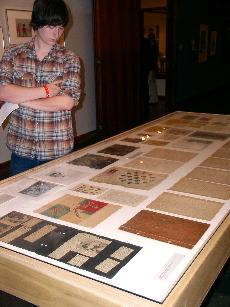‘Outsider art’ displayed at Krannert exhibition

September 26, 2006
A pair of Monarch butterflies surf on two leaves, and a hound dog hangs by its tail from a tree that bears hot dogs instead of fruit. Such is the imaginary world that Robert Bannister’s drawings reveal to us at the Krannert Art Museum’s current exhibition, “Cosmic Consciousness: the Works of Robert Bannister.”
A local artist born in Urbana in 1911, Bannister was what might be called an “Outsider Artist.” He was not formally trained and did not seek out art galleries or critics in order to secure his work.
He lived alone in a small room on Prairie Street, and he would walk to Walgreens once a day to get something to eat, carrying with him a roll of drawings to share with anyone who was interested in looking.
Bannister had tuberculosis as a child. When his father died of the same illness, Bannister was admitted at the age of six to Urbana’s Outlook Sanitarium (currently Cunningham’s Children’s Home) with his mother.
After his mother died in 1925, he lived with “foster grandparents” until he entered the Champaign County Nursing Home in the mid-1950’s. At the nursing home Bannister’s art began to take shape.
Get The Daily Illini in your inbox!
An occupational therapy program at the nursing home brought him art tools and an environment that allowed his inner worlds to flourish.
These inner worlds are populated with strange humans and creatures rendered with an intensity that carves them out of the blank page, reflecting Bannister’s earlier interest in woodcarving.
These two-dimensional works reflect a belief that he had a “cosmic awareness of human life,” according to Glen Davies, the curator of the show and a collector of Bannister’s work.
The people populating this world are meticulously wrought in pen as if he were weaving every fiber of muscle of the figures with ink. They exist often in shallow space with simple horizons of earth and sky that we might see in a child’s drawing, but the intense rendering makes them more substantial.
Bannister preferred to work with simple materials like Bic pens, crayons, and non-archival paper, though his friends and admirers often would provide him with better supplies.
These manifestations of his psyche seem less about making art and more about communicating his internal universe – a universe that he linked to the greater universe around him.
Davies gave a gallery talk last Thursday night, Sept. 21, and he opened by saying that some of those in attendance might be wondering, “How could an artist like Robert end up in a museum like this?”
So-called “Outsider” and “na’ve” artists exist outside the world of galleries and museums, and when they end up in those places it is often an awkward fit, he said.
The terms themselves, “Outsider” and “na’ve,” are inherently pejorative, and they are labels assigned by the Art World, presumably the “insiders” and the “experienced.” The labels are necessary to establish a hierarchy, and they seem necessary to make clear that these artists have less responsibility to art criticism or art history.
In 1945, Jean Dubuffet was an early champion of what he called Art Brut, or “raw art.” This was specifically the art of the mentally ill, the “primitive,” the “na’ve,” or, as Dubuffet explained, “anyone who has never learned to draw.”
Davies referenced Dubuffet as being an important influence in what originally drew him to Bannister’s work.
In 1951 Dubuffet had gone to Chicago to give his manifesto outlining Art Brut, and the effect was still working through the Art Institute of Chicago when Davies attended. For many artists, the movement created a break from academic art. It had an appealing directness, passion, and intensity that were not accepted in the professional art world.
Bannister’s work has these same qualities. There is a refreshing vibrancy in the colors, simplicity of compositions, and an immediacy about the drawings that pull the viewer into the artist’s world. Some of the figures are very reminiscent of Matisse’s dancers in form and color, and they also play on the themes of innocence and experience.
Bannister’s drawings are more like the “word-pictures” so often discussed in the realm of comic art (another “outside”) in which the pictures are bound to language in a very different way than most traditional works of art. These drawings are less about illusion and artist statements than about directly communicating to the viewer with the drawing alone.
According to Susan Martens Bloomfield, another collector of Bannister’s work, “He rarely talked about the meaning of his work and was puzzled and amused that people would ask (about it).”
Often humorous romps through a man’s inner thoughts, Bannister’s drawings do not belong to the category of the “na’ve.” While floating heads ride spaceships, there is not just the play of child-like innocence, but the play of a man dealing with the world around him with the best tool at his disposal: art.
The exhibition, at the Krannert Art Museum, 500 E, Peabody Dr., will be open through Oct. 15.






